Jewish life abounds in symbols and religious objects – visual and tangible representations of its many lofty values and ideals, which words alone cannot adequately describe. Not all of these symbols are equal in sanctity. Because the content of the mezuzah is from the Torah and is prepared in an identical manner as a Torah scroll, they help us reenact time-honoured rituals and bring aspects of the Jewish people’s long history to life.
Here are some of the most popular Jewish symbols and their meanings.
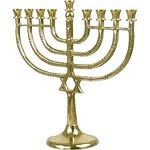 Menorah – The menorah is described in the Bible as the seven-branched candelabrum made of gold and used in the portable sanctuary set up by Moses in the wilderness and later in the Temple in Jerusalem. Fresh olive oil of the purest quality was burned daily to light its lamps. The menorah has been a symbol of Judaism since ancient times and is the emblem on the coat of arms of the modern state of Israel. The Roman-Jewish historian Flavius Josephus states that three of the seven lamps were allowed to burn during the day also; however, according to the Talmud, only the center lamp was left burning all day, into which as much oil was put as into the others. Although all the other lights were extinguished, that light buried oil in spite of the fact that it had been kindled first. Menorah – The menorah is described in the Bible as the seven-branched candelabrum made of gold and used in the portable sanctuary set up by Moses in the wilderness and later in the Temple in Jerusalem. Fresh olive oil of the purest quality was burned daily to light its lamps. The menorah has been a symbol of Judaism since ancient times and is the emblem on the coat of arms of the modern state of Israel. The Roman-Jewish historian Flavius Josephus states that three of the seven lamps were allowed to burn during the day also; however, according to the Talmud, only the center lamp was left burning all day, into which as much oil was put as into the others. Although all the other lights were extinguished, that light buried oil in spite of the fact that it had been kindled first. |
|
|
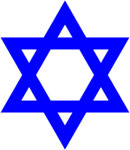 Star of David – Its shape is that of a hexagram, the compound of two equilateral triangles. The hexagram has been in use as a symbol of Judaism since the 17th century, with precedents in Central Europe in the 14th to 16th centuries, where the Shield of David was partly used in conjunction with the Seal of Solomon (the hexagram) on Jewish flags. The hexagram has appeared occasionally in Jewish contexts since antiquity, apparently as a decorative motif. For example, in Israel, there is a stone bearing a hexagram from the arch of a 3-4th-century synagogue in the Galilee. Star of David – Its shape is that of a hexagram, the compound of two equilateral triangles. The hexagram has been in use as a symbol of Judaism since the 17th century, with precedents in Central Europe in the 14th to 16th centuries, where the Shield of David was partly used in conjunction with the Seal of Solomon (the hexagram) on Jewish flags. The hexagram has appeared occasionally in Jewish contexts since antiquity, apparently as a decorative motif. For example, in Israel, there is a stone bearing a hexagram from the arch of a 3-4th-century synagogue in the Galilee. |
| Chai – This symbol, commonly seen on necklaces and other jewelry and ornaments, is simply the Hebrew word Chai (living), with the two Hebrew letters Cheit and Yod attached to each other. |
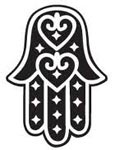 Hamesh Hand – The Hamesh hand or hamsa hand is a popular motif in Jewish jewelry. In many cultures around the world, this hand pattern represents protection against the evil eye, and the evil eye has historically been a popular superstition among Jews. Hamesh Hand – The Hamesh hand or hamsa hand is a popular motif in Jewish jewelry. In many cultures around the world, this hand pattern represents protection against the evil eye, and the evil eye has historically been a popular superstition among Jews. |
 Dreidel: The Dreidel is a popular Jewish symbol associated with the religious holiday of Hanukkah. The term is a Yiddish derivation of the German word ‘Dreden’, meaning ‘to turn’. Its Hebrew name is ‘Sevivon’, which traces its roots to ‘savov’ that also denotes ‘to turn’. Dreidel: The Dreidel is a popular Jewish symbol associated with the religious holiday of Hanukkah. The term is a Yiddish derivation of the German word ‘Dreden’, meaning ‘to turn’. Its Hebrew name is ‘Sevivon’, which traces its roots to ‘savov’ that also denotes ‘to turn’.The Dreidel is a 4-sided spinning top, a gambling toy that is a Jewish variant of the European ‘Totum’ or ‘Teetotum’. It is usually used during Hanukkah by children to play for gelt, which may comprise of coins, chocolate coins, candy, nuts, etc. The Dreidel is inscribed with 4 Hebrew letters, one on each side. These are Nun, Gimel, Hei and Shin, where nun stands for ‘nothing’, Gimel for ‘all’, Hei for ‘half’ and Shin for ‘put in’ and these terms govern the flow of the gambling game. It is believed that the four letters are an acronym for ‘Nes Ggadol haya sham’ that means ‘a great miracle happened there’, thereby signifying the importance of the Hanukkah festival. |
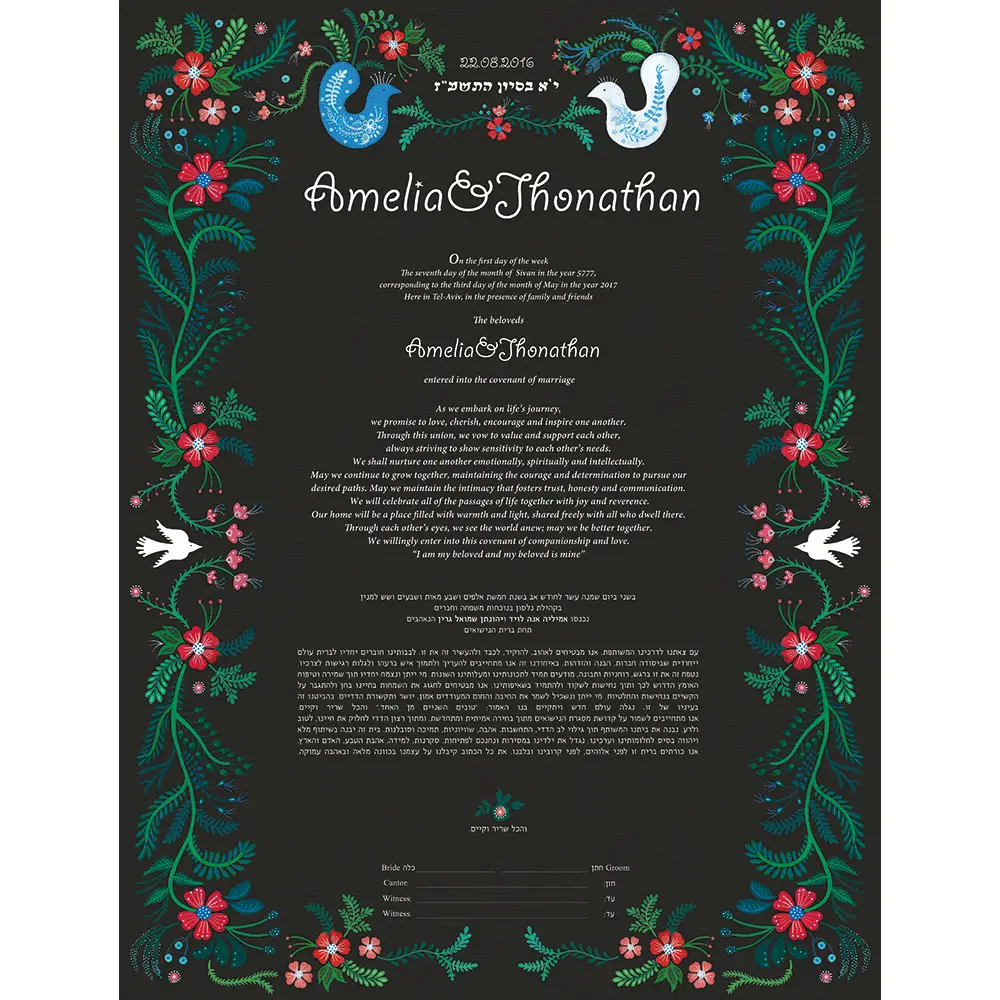 Ketubah: The Ketubah is a Jewish marriage certificate that outlines the rights and responsibilities of the groom in relation to the bride. It is a time-honoured practice and an essential part of a traditional Jewish wedding ceremony. Though historically, the Ketubah primarily served as a binding legal document, today, it is created as an artistic expression that serves as a lasting and beautiful reminder of mutual commitment. Ketubah: The Ketubah is a Jewish marriage certificate that outlines the rights and responsibilities of the groom in relation to the bride. It is a time-honoured practice and an essential part of a traditional Jewish wedding ceremony. Though historically, the Ketubah primarily served as a binding legal document, today, it is created as an artistic expression that serves as a lasting and beautiful reminder of mutual commitment. |
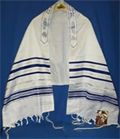 Tallit and Tzitzit: Tallit is a four-cornered Jewish prayer shawl that men and women wear during the morning service. Ideally, the garment should be big enough to be draped over the shoulders and should not be made from a mix of wool and linen. The religious significance of the Tallit lies in the Tzizit, the detailed fringes that are tied to each corner of the Tallit in accordance with commandments in the Torah. The Tallit and the Tzizit are meant as reminders of the Mitzvot, for preparing the mind and the heart for prayer, and for inspiring reverence for God. Tallit and Tzitzit: Tallit is a four-cornered Jewish prayer shawl that men and women wear during the morning service. Ideally, the garment should be big enough to be draped over the shoulders and should not be made from a mix of wool and linen. The religious significance of the Tallit lies in the Tzizit, the detailed fringes that are tied to each corner of the Tallit in accordance with commandments in the Torah. The Tallit and the Tzizit are meant as reminders of the Mitzvot, for preparing the mind and the heart for prayer, and for inspiring reverence for God. |
The symbolic values of numbers
The number three was the symbol of holiness. The Holy of Holies occupied one-third and the Holy Place two-thirds of the entire Temple. The tapestries were ten times three ells in length, and there were three vessels each for the altar of burnt offering, the altar of incense, and the Ark. The candlestick had twice three arms (besides the shaft, which also held a lamp), and each arm had three knobs. The priest’s blessing consisted of three sections, and in the invocation of God, the word “holy” was repeated thrice.
The symbolism of the number four was based on contemplating the quaternity as found in the universe, which included both heaven and earth. The number four connoted heaven as the throne of God.
The Holy of Holies was in the form of a cube, and the Holy Place was a double cube in length. All the vessels of the Temple in Jerusalem (except the candlestick) were rectangular. According to Ezekiel i. 26-28, the number four symbolized the divine revelation, while in the view of Philo it was the number of complete harmonies.
The number five typified semicompletion. The dimensions of the curtain of the Holy of Holies were four ells by five; the altar in the court covered a surface of five square ells, and there were five pillars at the entrance to the Tabernacle.
The number six symbolizes imperfection.
The number seven was the general symbol for all association with God and was the favourite religious number of Judaism, typifying the covenant of holiness and sanctification, and also all that was holy and sanctifying in purpose. The candlestick had seven lamps, and a sevenfold sprinkling accompanied the acts of atonement and purification. The establishment of the Sabbath, the Sabbatical year, and the year of jubilee is based on the number seven, as were the periods of purification and of mourning. The number 7 is the Divine number of completion.
The number eight symbolizes new beginnings. According to Kaballah in the Zohar, the number eight number signifies this because the eighth day was the first day after creation when God returned to work; the week began again.
The number ten symbolizes absolute completeness. The court to the Tabernacle was ten times ten ells long and five times ten ells wide, and in the Holy of Holies, the Ten Commandments were preserved.
The number twelve, being the product of three and four, typified the union of the people with God. On the table were twelve loaves of showbread, and the breastplate of the priest contained twelve precious stones as emblems of the twelve tribes of Israel, which camped around the Sanctuary.
The number thirteen symbolizes the principles of faith and God’s mercy.
The number eighteen is considered significant because the Hebrew word for “life” is (chai), which has a numerical value of 18.
The number twenty-six symbolizes God’s name.

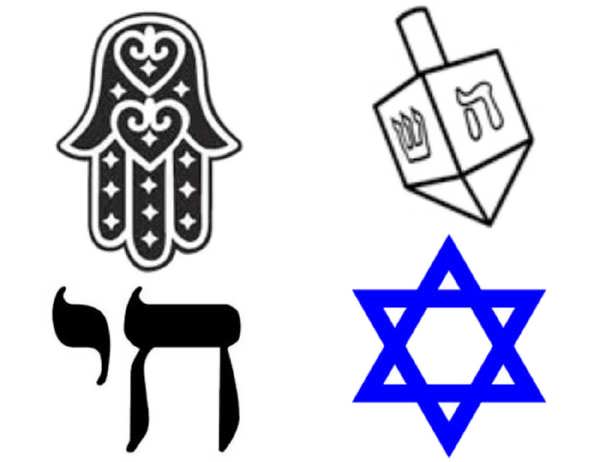
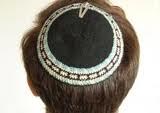 A kippah or kipa, also known as a yarmulke or Hech cap, is a hemispherical or platter-shaped skullcap, usually of cloth, often worn by Orthodox Jewish men to fulfill the customary requirement that their head be covered at all times, and sometimes worn by both men and, less frequently, women in Conservative and Reform communities at times of prayer.
A kippah or kipa, also known as a yarmulke or Hech cap, is a hemispherical or platter-shaped skullcap, usually of cloth, often worn by Orthodox Jewish men to fulfill the customary requirement that their head be covered at all times, and sometimes worn by both men and, less frequently, women in Conservative and Reform communities at times of prayer.